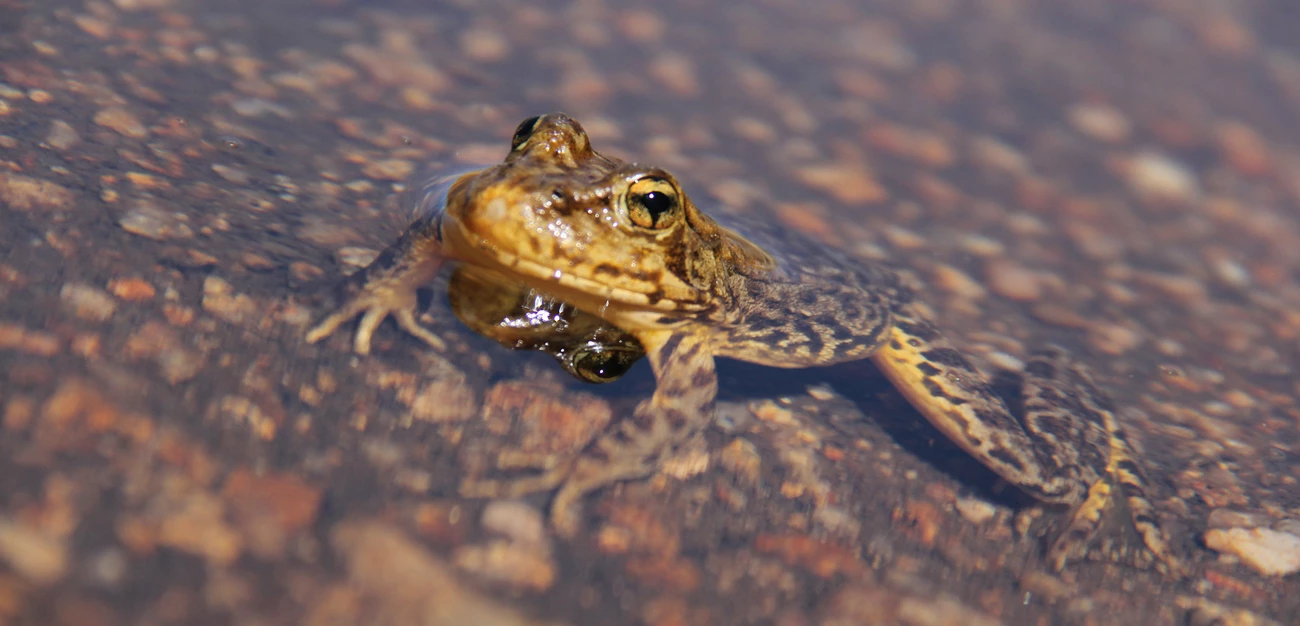
The Sierra Nevada yellow-legged frog evolved in the fishless waters of Yosemite: "... advent of fish in a lake sooner or later nearly or quite eliminates the frogs. It seems probable that the fish prey upon the tadpoles, so that few or none of the latter are able to reach the stage at which they transform. The frogs which live along the streams probably spawn in small temporary pools in the meadows which the trout cannot reach." - Animal Life in the Yosemite by J. Grinnell and T.I. Storer, 1924 Basic Biology

History...to Today At one time the rare Sierra Nevada yellow-legged frog (Rana sierrae) was the most abundant amphibian in the high mountain lakes of the Sierra Nevada. Visitors hiking along lakeshores could encounter frogs by the hundreds. Populations have since declined approximately 95% in the Sierra Nevada, including in Yosemite. Recent surveys in 2005-2007 determined that the species is still declining and on a trajectory toward extinction. Because of this, the frog has been listed as an Endangered species for protection under the Federal Endangered Species Act. The ecological effects of the loss of the Sierra Nevada yellow-legged frog from most of its range have been significant, as their former abundance made them a keystone predator and prey and a crucial agent of nutrient and energy cycling in Sierra Nevada aquatic and terrestrial ecosystems. Multiple factors have contributed to the decline of the frog, including the introduction of fish into naturally fishless waters throughout most of the park. As early as the turn of the 20th century, scientists in Yosemite noticed that frogs and fish rarely occurred in the same lake or stream. Non-native trout feed on eggs, tadpoles, and young adults and compete for natural food sources. Although fish stocking in Yosemite ceased in 1991, many non-native trout populations continue to exist. Studies suggest that the recently discovered amphibian chytrid fungus is a major contributor to observed declines in the Sierra Nevada yellow-legged frog. Chytridiomycosis, an often fatal disease, was first discovered in the Sierra Nevada in 2001. Subsequent studies have found that the chytrid fungus has been present in the Sierra Nevada at least since the mid-'70s. The chytrid fungus appears to live on keratin—the same substance fingernails are made of—found on the external mouthparts of tadpoles, and in the outer skin layer of adults. The growth of the fungus on adult’s skin apparently disrupts the frog’s ability to breathe through its skin and osmoregulate—sustain an internal water balance; both effects resulting in nearly certain death. Much still needs to be learned about the chytrid fungus, what its origins are and how it is spread. Research suggests that the fungus is a "novel pathogen," meaning that it has recently spread from outside the geographic area to highly susceptible local species that did not evolve with the pathogen. Chytrid fungus has occurred in African clawed frog populations at least since the 1930s and is rarely fatal in this species. The African clawed frog has been transported around the world first for human pregnancy tests in the 1940s-1950s and later for laboratory testing and as pets. Release of animals into the wild could have infected new geographic areas. Also unknown is how the fungus moves between water bodies. While the fungal disease is highly fatal to Sierra Nevada yellow-legged frogs, there is some hope. A small number of frog populations have been able to persist and some populations have even increased in size despite the presence of the chytrid fungus. Ongoing research supported by the National Science Foundation is investigating why these few populations have been able to hang on. Such research will contribute to development of strategies to reestablish populations of frogs in the future. Additional causes of decline may include deposition of airborne contaminants, such as pesticides and other chemicals, from sources outside the park, other pathogens, and possibly a combination of these and other stressors. Two ongoing projects are being conducted in Yosemite to determine the feasibility of expanding the distribution of the frog in the park. The park began a Yosemite Conservancy supported project in 2006 to re-introduce the frogs into several fishless lakes and started a project in 2007, supported by entrance fee funds, to restore habitat by removing non-native fish from a handful of remote sites. Research has shown that once fishless, the lakes are re-populated by native species, including frogs and invertebrates.
Visit our keyboard shortcuts docs for details
Can we save the Sierra Nevada yellow-legged frog from extinction? Human introduced non-native species (fish and fungus) have been causing the frog to go from the most abundant amphibian in the Sierra Nevada to critically endangered. However, habitat restoration efforts in Yosemite are showing promising signs for the frog's recovery and long-term survival. |
Last updated: November 19, 2024
